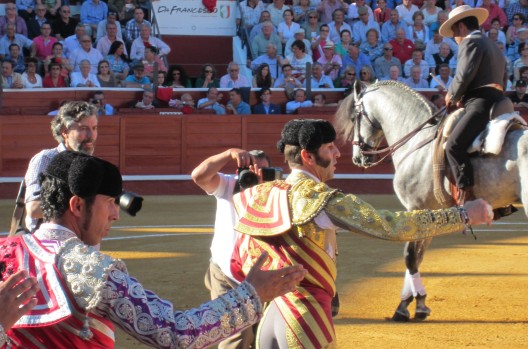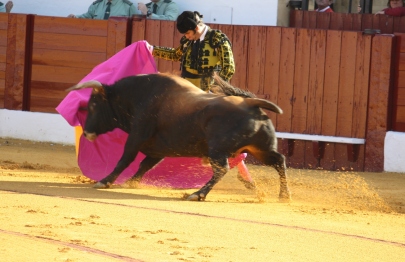Last night I filed my copy – and I fear as a result missed the birthday party of Don Tristán Ybarra n the feria – about bullfighting and reality television, the corrida and Made In Chelsea for my column in Taki’s magazine. It has been edited, as is always the case. However, this time I prefer the long version, not least as is is not quite so savage to Ollie Locke, whom I know, and his amusing little book, Laid in Chelsea.
Alexander Fiske-Harrison

Last night, while seated in the La Maestranza bullring of Seville to watch the great matador José Marí Manzanares dance with and dispatch six bulls, I was reminded once again why I became so fascinated by the spectacle we ‘Anglo-Saxons’ incorrectly call bullfighting. (It is not a fight, but a highly structured drama centring on a ritual sacrifice. Nor is it a sport, but is conceived of as an art-form, unique in having a risk of death for the practitioner, but reviewed between the ballet and theatre in the newspapers and spoken of in terms of its aesthetics rather than its athletics.)
My girlfriend, a recent convert but still possessed of strong and valid doubts about the activity, asked what it was amongst the gold and the gore that draws me back to the plaza de toros time and time again. The answer I gave was the absolute reality of the corrida. As an art-form, it represents man’s struggle with death, and how it should be best faced, which is with a striking and elegant defiance. However, it is the only art-form that also is what it represents, which is a man standing alone on the sand with an animal intent on killing him. And kill they do: 533 noted professional toreros have died in the past three centuries, and a far greater number number of less famous ones and amateurs. My first instructor in how to torear, the matador Juan José Padilla, almost joined their ranks two years ago when a bull removed his eye and a chunk of his skull. Needless to say he was back in the ring five months later, sans depth perception, a triumphant return which I covered for GQ magazine here.
I come to Seville whenever I can to see these exceptionally brave men stand in front of these beautiful bulls, the best time of year being now as the town prepares for its annual celebration of the death of winter, the feria de abril, ‘April Fair’. This year I am not here on holiday, but have come to meet with another matador, Cayetano Rivera Ordóñez, about whom I am co-producing and writing a documentary. Cayetano has risen to fame and riches through risking his life in this way, a risk he knows all too well. His father, the matador Paquirri, was killed by a bull when Cayetano was just seven years old.
Whatever one thinks of the ethics of injuring and killing an animal as part of a public spectacle – personally I find it no less reprehensible than killing one at a third the age and after a far worse life for meat I do not medically need to eat – there is an undeniable honour and glamour in earning your status and fortune by dancing with death.
Which is why it stands in such stark contrast to what passes for honour and glamour in my home country of Great Britain. I say this having just attended the book launch of an acquaintance who had brought out his memoirs at the ripe old age of 26. I say memoirs, it is more accurately described as a travelogue of his sexual adventures, something made clear by its title Laid In Chelsea. It is currently at number three in the Sunday Times bestseller list. The reason for this literary success is because the author, Ollie Locke, is famous for being in a reality television show called Made In Chelsea.
Now, I must admit up front my envy at his book sales. My own travelogue Into The Arena: The World Of The Spanish Bullfight didn’t make it onto the bestseller lists, even after it was erroneously but flatteringly shortlisted for the William Hill Sports Book Of The Year Award. (See earlier comments about the corrida not being a sport.)
The fact that having your life filmed and broadcast, and then writing about your carnal exploits, can bring wealth and glory neatly sums up so much that is wrong with modern Britain, a generalisation that extends to our Saxon cousins in the US. Spain may be financially bankrupt, but at least it isn’t morally so.
I should add here that the book is actually quite readable, although that is helped by the fact that I know some of the people in it. Indeed, I’m even related to one of them. The author himself, Ollie Locke, is a witty and charming young man, with the bizarrely marketable talent of being good at being himself. However, he is also the sort of person – I’m sure he won’t mind me remarking on this – that had to have explained to him for an hour why the girl to whom he lost his virginity might not like that event written up and published.
Having the sexual ethics of an alley cat to one side, the reason I cannot watch Made In Chelsea, despite having grown up there and knowing some of the cast, is that no one on it ever does, or has ever done, anything worthy of note. It is a parade of moderately good looking people having rather stilted conversations about one another’s utterly irrelevant and pedestrian personal lives. I know these people and find it unspeakably dull; God knows what anyone else sees in it. Fiction was invented to get away from exactly this sort of tedium.
However, when people use that oxymoronic and false phrase ‘Reality Television’, it is not Made In Chelsea, or Big Brother, or any of those other monstrosities that spring to mind. It is the television footage of Cayetano’s father, being tossed by that bull in 1984, and then the footage afterwards of him in the hospital, fully conscious, reassuring and calming the panicking surgeons as they struggle in vain to stop his life from haemorrhaging out onto the bed sheets where he lay. That was how Paquirri justified his salary and his celebrity, by paying the ultimate price, and facing it with a courage and grace at the end that beggers belief.
That his son – both sons in fact – should follow in his shoes, makes him truly deserving of having his life told as a story, on film and in print. Something Ernest Hemingway felt similarly about when he wrote the articles about Cayetano’s grandfather Antonio Ordóñez that were posthumously published as the book The Dangerous Summer. And when he fictionalised his 1924 encounter with Cayetano’s great grandfather, also called Cayetano, in Pamplona as The Sun Also Rises. Some people are deserving of recognition and others not. The British and American inability to distinguish between them is at the heart of our ethical, and aesthetic decline.






























